


01 Sep
After years of progress in keeping rabies under control, the virus is starting to show up again in parts of the United States. Communities that had gone nearly a decade without cases are now reporting new outbreaks, raising concern among health officials.
In Nassau County on Long Island, rabies was officially declared an “imminent public health threat” this summer. Officials identified 25 rabid animals, mostly raccoons and stray cats, in areas that had not seen the disease in almost ten years. Texas is also dealing with a surge. A bat at the San Marcos outlet mall tested positive, and state health services have already confirmed 94 rabid bats this year, with the most activity in Austin, Houston, and San Antonio.
Experts believe several factors are fueling the rise. In Nassau County, the end of a rabies vaccine baiting program along the Nassau-Queens border is thought to have allowed infected wildlife to move in from New York City. Across the country, rabies continues to spread mainly through wild animals like raccoons, skunks, foxes, and bats, which account for more than 90% of U.S. cases. To fight this, the U.S. Department of Agriculture (USDA) has restarted oral vaccine programs in eastern states, dropping bait that immunizes animals when eaten.
The danger is not limited to cities only. At Grand Teton National Park’s Jackson Lake Lodge, bats were found inside many guest cabins. Officials warned that as many as 500 visitors could have been exposed. While few bats tested came back negative, many did not, leading health officials to recommend preventive treatment for guests who may have had contact.
Even though human rabies is very rare in the U.S. with fewer than 10 deaths each year, the disease remains a serious threat. In early 2025, a Michigan resident died after receiving an organ transplant from someone who had rabies. In late 2024, two more people in Minnesota and California died after being exposed to bats.
Rabies is almost always fatal once symptoms appear. It spreads through bites or scratches from infected animals or if their saliva gets into a wound, the eyes, or the mouth. Symptoms can take days, weeks, or even months to develop. Prevention is the best defense: vaccinating pets, staying away from wild animals, getting medical help quickly after possible exposure, and continuing strong surveillance programs.
This September, Nassau and Suffolk Counties plan to restart oral vaccine bait drops aimed at young wildlife to reduce the spread. At the same time, the USDA will continue its 2025 vaccine distribution in eastern states. Health officials are reminding the public to keep pets vaccinated, avoid wild animals, and seek care immediately if there’s any chance of exposure.
With rabies returning to places once considered safe, the risk to communities, especially in crowded areas and popular tourist spots, is growing. Vaccination programs, close monitoring, and quick medical response remain the strongest tools against this deadly disease.

AUTHOR’S BIO
ARSH BHARDWAJ
I am passionate about language, storytelling and the human urge to connect Having paid close attention to marketing and branding as a craft for some time, I'm eager as ever to indulge my passion for prose.